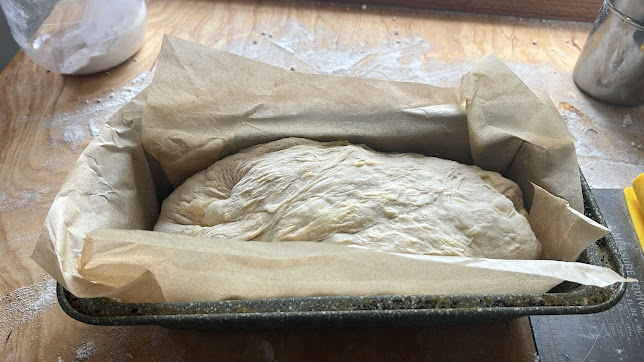"Sourdough Croissant" Bread
Welcome to another step-by-step recipe from BreadClub20. Why not drop by our main Facebook page by clicking here... If you like what you see and enjoy the recipe, we hope you join us by 'Liking' and 'Subscribing'.
What is often referred to as 'Spurdough Croissant Bread' is becoming increasingly popular in certain parts of the world. Its presence on internet sourdough sites and interpretations by certain bakers makes it of interest.
However, it's an invention and a hybrid. It isn't strictly a sourdough bread, although it's leavened by sourdough, and it isn't strictly a croissant dough (or a Danish pastry dough, aka Wienerbrødsdej) although it does have simple lamination and the addition of butter.
However, if I invented my own name for it, no one would be able to find it on this website, so I'm sticking with the common name and adding in punctuation marks.
And here's the BreadClub20 version of....well, whatever it's called!
INGREDIENTS
200 gms of active starter (made up from 20 gms of starter, 90 gms strong bread flour and 90 gms water - left for as long as it needs to, at least double, show signs of bubbling and smelling yeasty)
240 gms lukewarm water
360 gms strong white bread flour
12 gms sugar
10 gms salt
120 gms unsalted butter (frozen)
You'll need a flat bottomed dish - like a lasagne dish - for the lamination stage
METHOD
Preparing the dough
Combine the starter with the water and sugar. Add the flour and salt and bring together into a rough dough.
Cover and leave in a warm room for 20 minutes.
Stretch and fold the dough continually until the dough comes together into a smooth and shiny dough. This should take about 3 - 4 minutes. Alternatively, you can mix the dough by hand or even pop it into a mixer with a dough hook on low speed.
Cover and rest for 20 minutes back in the 'warm spot'.
Stretch and fold the dough, moving around the bowl until all the dough has had the same stretching and folding treatment.
Cover and rest for 20 minutes back in the 'warm spot'.
Now we move on to lamination
Mist your work surface and spread out the dough into a rough 14 inch square. Try and make sure the dough doesn't stick to the surface.
Using either the large holes of a box grater or a sharp potato peeler, grate or peel about two thirds of the frozen butter over the surface of the dough. This is the messy bit, especially if the butter finds itself in a warm pair of hands!
Fold the dough like a business letter so that you end up with a rectangle 14 inches by about 5 inches.
Grate or peel the remaining butter over the surface and then roll the dough into a log that's 5 inches wide.
Place the dough into a lightly-greased flat dish (like a lasagne dish), cover and let it rest for 30 minutes at room temperature (21⁰C / 70⁰F) .
After 30 minutes, wet your hands and coil fold the dough, picking it up in the middle, lifting it and then letting it fall back on itself. Turn the container 90⁰ and repeat with another coil fold.
Cover and let it rest for 30 minutes.
Perform a second coil fold, then cover the container and leave it for about 2 - 4 hours until it is puffy and risen. It may not have doubled, but it should be fluffy and bubbly.
Prepare a proofing banneton or baking tin.
Gently transfer the dough to a well-floured worktop. Shape to suit the baking container / banneton and lace the dough into it. (You may wish to line a loaf tin with parchment paper to stop the dough sticking to the sides of the tin.
Leave covered for one hour at room temperature (21⁰C / 70⁰F) and then place in a plastic bag and place on the bottom shelf of a refrigerator until the next day.
After an hour....it's ready for the refrigerator and a cold overnight sleep. The dough will continue to expand as it cools down, so leaving a little room i the banneton is never a bad idea.
The following day:
Preheat the oven to 240C (475F).
Preheat either a covered baker or a stone or steel.
Fifteen minutes before baking, remove the dough (in the banneton or loaf tin) from the refrigerator
When ready to bake, either place the dough (scored to allow for expansion) in the covered baker, on the stone or on the steel (don't forget to use a piece of parchment paper underneath) or place the loaf tin on the shelf in the oven (again, don't forget to score the dough).
Tip : if you bake under cover, you may find that the loaf tin will sit inside the bakgn container.....might save you having to add extra steam?
Drop the temperature to 220⁰C (430⁰F) and bake for 45 minutes. (remove the lid on the covered baker after 30 minutes).
The loaf will be done when the upper crust is darkened and the internal temperature is at least 95⁰C (200⁰F)
Cool on a rack. The bread will slice better if left until the following day.

















What a treat
ReplyDelete